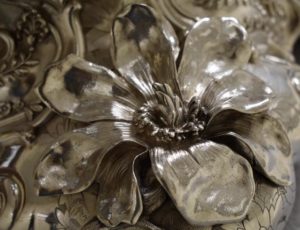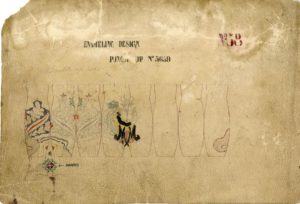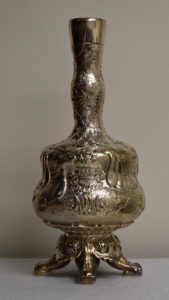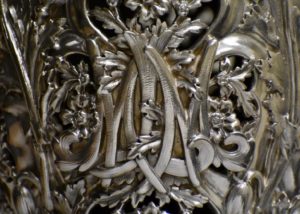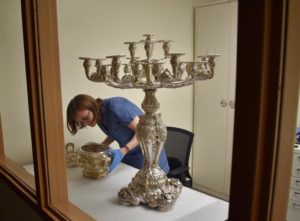Tiffany & Company’s Spectacular Mackay Silver Service
EMERGING SCHOLARS > SUMMER RESEARCH GRANTS
Christine Garnier,
Department of History of Art and Architecture, Harvard University
In the basement of the Keck Museum of the Mackay School of Mines sits a treasure trove in the form of a single silver service, the culmination of an industrial legacy originating 26 miles south at the mines of the Consolidated Virginia Mining Company. Lore maintains that John Mackay transported all 14,719 ounces of silver for his wife’s dinner service from the mine by train to the New York workshops of Tiffany & Company in 1877.1 At the height of the Gilded Age, Mrs. Marie Louise Hungerford Mackay amazed the guests at their Parisian mansion at 9 Rue de Tilsitt with the 1,250-piece set, announcing the family’s rise as a Western industrial and social powerhouse.2
Through the support of a Decorative Arts Trust Summer Research Grant, I traveled to Virginia City, NV, the University of Nevada at Reno, and the Tiffany & Company Archives in Parsippany, NJ, to investigate this under-studied service for my dissertation, Amalgamating the West during the American Silver Age. My research examines the role of silver in mediating the social rise of the West during the mid-to-late 19th century. The Mackay service is the centerpiece of a chapter on the visual rhetoric of silver mining during the Free-Silver Movement of the 1870s, a political faction of Western industrialists who advocated for the expansion of American monetary policy with the inclusion of coin silver.
The complex chased motifs shift throughout the 24 settings in pattern, size, and position, producing a continuous yet varied landscape of American flora rendered in silver. Through the generous assistance of Keck Museum Curator Garrett Barmore, I examined the interiors of the candelabras to note how silversmiths used drop presses to expedite the repouseé process and observed anomalies where stamps were accidentally misaligned. Photographs and ledgers in the business archive of the Consolidated Virginia Mining Company housed in the UNR Special Collections helped contextualize larger questions about industrial labor relative to the cost of the service, which was nearly equal to one month’s worth of wages for all mine employees in 1877.
Under the supervision of Edward Moore, Tiffany & Company required two years to complete the commission, engaging as many as 200 men in much of their design, chasing, and production forces between 1877 and 1879. A tour de force of the company’s capabilities, selections from the Mackay Service were a central part of its display at the 1878 Exposition Universelle in Paris. The US Commissioner-General to the Exposition, the Honorable R. C. McCormick, expressed his delight at the service’s design, “a combination of Oriental styles, producing richness and harmony of effect, and, while unity of character has been preserved throughout the whole service, individuality has been given to each piece, either in form or decoration.”3
This balance of unity and individuality runs throughout every component of the set, from the gourd-inspired silhouettes of the wine coolers to the unique color-schemes of the enameled cutlery, butterfly napkin rings, and cups. The intricacy of the service provided an opportunity for the firm to display almost every new technical innovation, from their creative use of drop presses to a foray into enameled wares, as well as the sheer artisanal might harnessed to produce the largest American dining service to date. Themes of technological prowess and skilled labor were echoed throughout the rest of the Company’s display in Paris, including an electrotype copy of the 1876 Vase made in honor of William Cullen Bryant, a former brother-in-law of Mrs. Mackay from her first marriage. Having “retouched silver surfaces with light,” a critic from the Gazette des Beaux Arts reported, “the beholder is not afraid to put his fingers on the polished surface, no longer hard and cold; the pores and wrinkles of skin, fibers of foliage, and the bloom and grain of fruit are wonderfully reproduced.”4
Design was not the only element that captured the attention of journalists. Numerous critics also remarked on the history of the silver itself, mined from Mackay’s legendary Comstock Lode. At this time, Federal regulations required major design firms to purchase their raw material as coinage directly from the New York Stock Exchange, and the U.S. mint did not circulate silver between 1873 and 1878, when gold served as the only monetary standard following a financial panic. Mackay’s source was therefore a rare phenomenon that represented the potential of an industry barred from the open market. When Mackay ordered the service, Western politicians and mining industrialists of the Free-Silver Movement were actively lobbying the government to pass the Bland-Allison act, which authorized the unlimited coinage of the silver dollar, thereby creating a guaranteed market for elite silver miners. The Mackay service went on display at the Exposition only a few days after Congress overturned President Rutherford B. Hayes’s veto to resume silver coinage on February 29, 1878, inadvertently signaling the successful emergence of a new financial and political power on an international stage.
At the Exposition Universelle, the Mackay Service provoked a range of discussions around silver mining, currency, and design in an international context. The Decorative Arts Trust allowed me to investigate the diverse issues that surround this extraordinary service, only accessible through the close study of the objects and their design and manufacture.
Notes:
1
Ellin Berlin, Silver Platter (Garden City, NY: Doubleday, 1957), 241.
2
Robert Hankins, the great grandson of John and Louise Mackay, gifted 58 of the most ornate pieces from this 1,250 piece set to the University of Nevada. While other pieces have remained in private collections, including that of the family, small items have found homes in museums across the world, from Los Angeles to Edinburgh.
3
Honorable R. C. McCormick, United States Commissioner-General to the Exposition Universelle, “Our Success at Paris in 1878,” North American Review, July 1879. Reproduced in Tiffany & Co. at the Exposition Universelle (Paris, 1878), 6. Tiffany & Co. Archives, Parsippany, NJ.
4
“Tiffany & Co.” Gazette des Beaux Arts (Paris, 1878). Reproduced in Tiffany & Co. at the Exposition Universelle (Paris, 1878), 15. Tiffany & Co. Archives, Parsippany, NJ.

